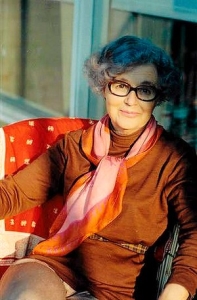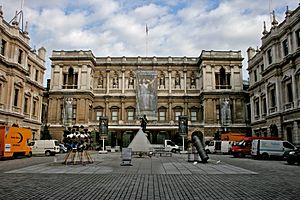Constance Stokes facts for kids
Quick facts for kids
Constance Stokes
|
|
|---|---|

Stokes in 1972
|
|
| Born |
Constance Parkin
22 February 1906 Miram, near Nhill, Victoria, Australia
|
| Died | 14 July 1991 (aged 85) |
| Education |
|
| Known for | Painting, drawing |
|
Notable work
|
|
Constance Stokes (born Constance Parkin, 22 February 1906 – 14 July 1991) was an Australian artist. She was known for her modern style of painting. Constance Stokes lived and worked in Victoria.
She studied art at the National Gallery of Victoria Art School until 1929. Then, she won a special scholarship to continue her studies in London at the Royal Academy of Arts. Even though she painted only a few works in the 1930s, her art became well-known from the 1940s onwards.
Constance Stokes was one of only two women chosen for a big art exhibition in the early 1950s. This exhibition featured twelve Australian artists and traveled to Canada, the United Kingdom, and Italy. Her work was highly praised by art experts both in Australia and overseas.
After her husband passed away in 1962, Stokes returned to painting full-time. She had a very successful art show in 1964, which was her first in 30 years. She kept painting and showing her art throughout the 1970s and 1980s. Her art is now displayed in most major Australian galleries, including the National Gallery of Australia.
Contents
Constance Stokes' Early Life and Art Training
Constance Parkin was born in 1906 in a small town called Miram, near Nhill in western Victoria. Her family moved to Melbourne in 1920. There, she finished her schooling at Genazzano FCJ College in the suburb of Kew.
From 1925 to 1929, Constance trained at the National Gallery of Victoria Art School in Melbourne. In 1925, she won a prize for a landscape painting in a student competition. The artist George Bell judged this competition. He would later become a very important influence on her art career.
In 1930, Stokes showed her art at a gallery in Melbourne called the Athenaeum. A famous artist named Arthur Streeton praised her painting, Portrait of Mrs. W. Mortill. He called it "rare attraction" and "liquid and luminous."
After her studies, Stokes won the National Gallery Travelling Scholarship. This allowed her to study at the Royal Academy of Arts in London. In 1932, she also studied in Paris with the French artist André Lhote, who was known for cubism, a style of art.
She returned to Australia in 1933 and married a businessman named Eric Stokes. They lived in Collins Street, Melbourne. Constance had three children between 1937 and 1942. Later, she had her own art studio in their home in Toorak.
Constance Stokes' Art Career
Early Artworks: 1934 to 1952
After returning from Europe in 1934, Constance Stokes did not paint much for several years. Only two paintings and two sketches from this time are known. One important work is The Village (around 1933–1935). Stokes said this painting was inspired by the artist Augustus John.
The Village was shown in the first exhibition of the Contemporary Art Society at the National Gallery of Victoria. It was also part of a traveling exhibition that went to New York's Metropolitan Museum of Art in 1941. Stokes later gave this painting to the National Gallery of Victoria in 1946.
In the mid-1900s, there were different ideas about art in Melbourne. Some artists preferred modernism, while others liked a style called tonalism. In 1940, artist George Bell started a group called the Melbourne Contemporary Artists. This group supported modern art. Stokes was one of the artists who exhibited with this group. Other members included Russell Drysdale.
Stokes' art remained popular, even when some other modern artists' works did not. In 1945, an art critic praised her painting The Family for its strong design. In 1946, the same critic called her pictures "rich and opulent." In 1952, another critic praised her work Christ with Simon and Andrew for its "richness and feeling."
Around this time, one of Stokes' portraits was shown in an exhibition in Perth. The local newspaper, The West Australian, featured her painting to show the exhibition. They called her work Girl Drying Her Hair and noted its "patient handling, use of bright colour and skilful blending." The National Gallery of Victoria owns this painting, calling it Woman Drying Her Hair.
Later Artworks and Exhibitions: 1953 to 1989
In 1953, a special exhibition of twelve Australian artists was put together. It was shown in London, other British cities, and at the Venice Biennale in Italy. Constance Stokes was one of only two artists from Victoria chosen for this important show.
Her three paintings, including Woman Drying Her Hair, were displayed alongside works by famous Australian artists like Arthur Boyd and Sidney Nolan. Stokes' painting Girl in Red Tights received special attention. The director of the National Gallery in London, Sir Philip Hendy, admired it. The Times newspaper even called it the "best picture in London that week."
Some artists in Sydney were not happy with the selection. However, the exhibition was seen as a major way to promote Australian art around the world. In 1954, a professor from the University of Melbourne praised Stokes' painting. He said her Girl in Red Tights showed "Venetian richness of colouring" and a "monumental harmony."
Constance Stokes often painted religious subjects. One of her works, The Baptism, is in the collection of the National Gallery of Victoria. She only entered the Blake Prize for Religious Art once, in 1953. She later said she didn't enter again because "abstract painting took over."
Her husband, Eric Stokes, died suddenly in 1962. This was a very difficult time for Constance. To help with money, she returned to painting full-time. Two years later, in 1964, she had her first solo art show in over 30 years. It featured 43 works and was a big success. She earned a lot of money and received praise from art experts.
Throughout the 1960s, 1970s, and 1980s, she continued to paint and hold exhibitions. Her later works used brighter colors and showed the influence of the artist Henri Matisse, whom Stokes admired. Her art was included in several important exhibitions, such as Australian women artists in 1975. Constance Stokes' last painting was Alice Tumbling Down the Rabbit Hole, painted around 1989. She passed away in Melbourne in 1991.
Constance Stokes' Legacy
McCulloch's Encyclopedia of Australian Art describes Constance Stokes as a "leading figure in the modernist movement in Victoria." However, some art historians believe her work is not as well-known as it should be.
Feminist writer Anne Summers wrote a book in 2009 called The Lost Mother. In this book, Stokes and her paintings are a main part of the story. Summers points out that Stokes is not as famous as other women artists like Grace Cossington Smith. She suggests this might be because Stokes was linked to George Bell, whose own reputation later faded. Also, Stokes lived in Melbourne, while many famous artists at the time were from Sydney.
Despite this, there is a strong market for buying and selling her artworks today.
In 1985, an exhibition of Stokes' paintings traveled to regional galleries in Victoria, including Swan Hill Regional Art Gallery and Geelong Art Gallery. The next year, her work was shown in several state galleries. In 1992, her paintings were part of an exhibition at the National Gallery of Victoria called Classical Modernism: The George Bell Circle. The same gallery also held an exhibition of her paintings and drawings in 1993.
Most major Australian art collections have works by Constance Stokes. The National Gallery of Victoria, for example, has thirteen of her paintings, including The Village. Because she was closely connected to Victoria and Melbourne, her art is well represented in galleries there. These include the Art Gallery of Ballarat, Benalla Art Gallery, Geelong Art Gallery, and Mornington Peninsula Regional Gallery.
Other public galleries that own her works include the National Gallery of Australia, the Art Gallery of South Australia, and the Queensland Art Gallery. The Art Gallery of New South Wales is the only major Australian gallery that does not have any of her paintings or drawings.
Images for kids
See also
 In Spanish: Constance Stokes para niños
In Spanish: Constance Stokes para niños



